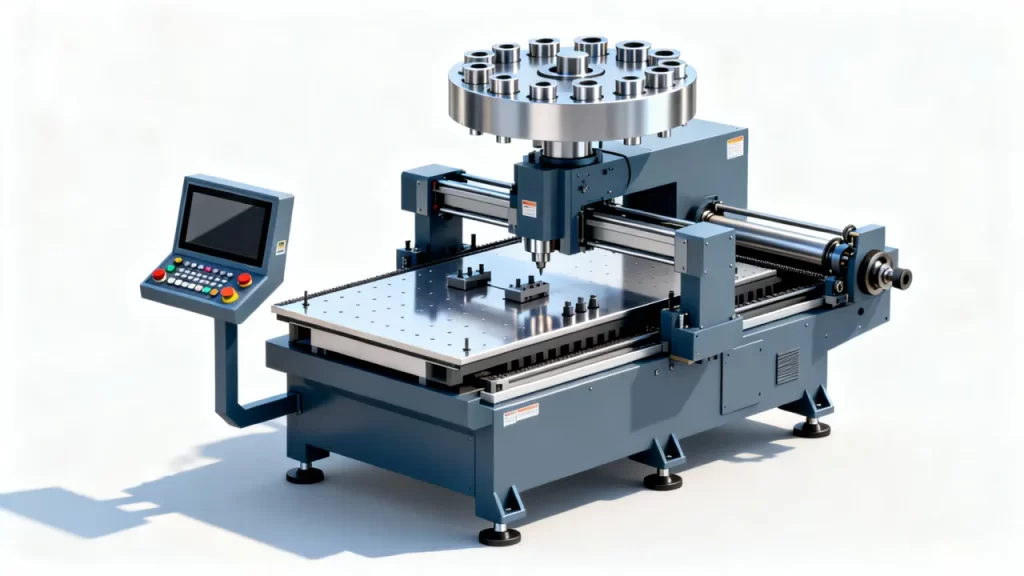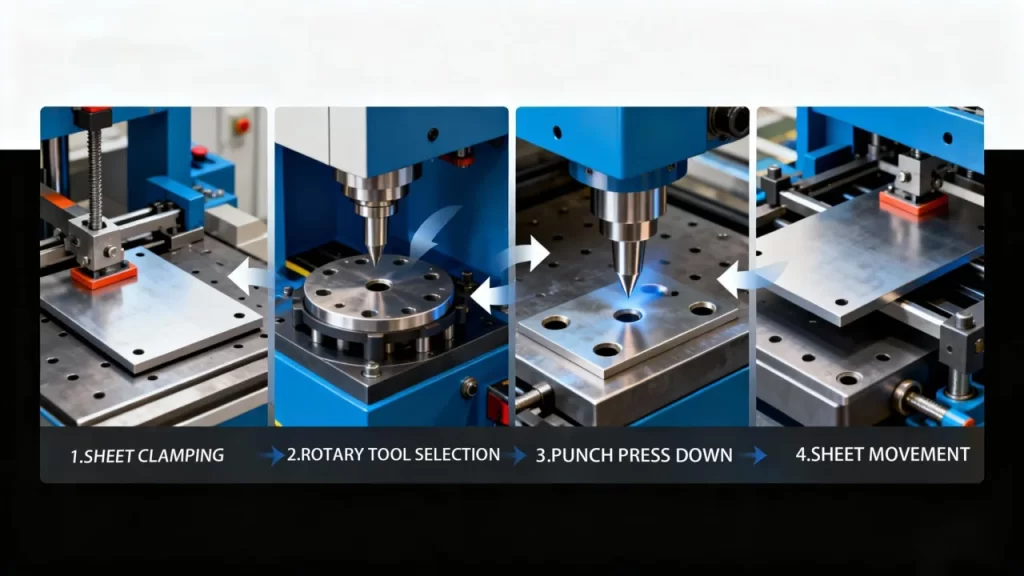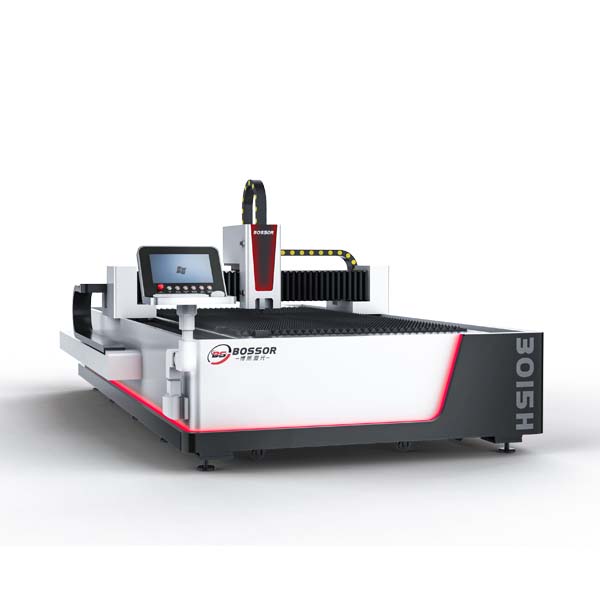Turret Punching Machine Explained: How It Works and Why It Matters in Modern Metal Fabrication
- Conhecimento, Notícias
- 90+ reading now
Discover how a CNC turret punching machine works, its key components, and why turret punch presses remain vital in modern sheet metal fabrication automation.
In modern metal fabrication, precision, speed, and flexibility define success. Among the many innovations driving this evolution, the turret punching machine stands out as a cornerstone of automated sheet metal processing. But what exactly is a turret punch press, how does it work, and why is it still essential in today’s era of laser cutting and smart manufacturing? Let’s explore.

A turret punching machine, often referred to as a turret punch or turret punch press, is a CNC-driven sheet metal processing machine that uses multiple punching tools arranged in a circular turret to create holes, forms, and shapes on metal sheets.
Unlike a traditional punch press, which typically relies on a single die set, a turret machine can switch between dozens of tools in seconds. This enables rapid, versatile fabrication without frequent manual setup changes.
Punching round, square, and custom holes
Forming louvers, embossments, and knockouts
Nibbling (contour cutting using small punches)
Applications:
HVAC panels, electrical enclosures, automotive components, elevator panels, and appliance casings.

At its core, a turret punch press operates through a combination of mechanical or servo-electric power, CNC motion control, and a rotating turret system.
Sheet positioning: The metal sheet is clamped and precisely positioned on the worktable.
Tool selection: The turret—a circular tool holder—rotates to bring the selected punch and die into alignment.
Punching stroke: The ram drives the punch downward into the die, cutting or forming the material.
Repositioning: The sheet automatically shifts for the next operation, guided by CNC commands.
This high-speed process can produce thousands of consistent holes per hour with accuracy as fine as ±0.05 mm.
A turret punching system integrates several precision-engineered components:
These two rotating disks hold the punches and dies, respectively. Each turret position corresponds to a specific tool set. CNC programming allows automatic indexing between tools, minimizing setup time.
The ram applies controlled force to the punch. Modern servo-electric systems offer smoother motion, energy efficiency, and lower maintenance compared to hydraulic models.
The worktable supports the sheet while clamps move it between punching positions. Brush or ball tables are used to prevent surface scratches.
The brain of the machine. It interprets CAD/CAM input, controls the tool changes, and ensures precise sheet movement. Many modern systems integrate with Industry 4.0 platforms for remote monitoring.
Compared with traditional punch presses, turret machines provide superior efficiency and versatility.
In an age of rapid manufacturing, the CNC turret punching machine remains an irreplaceable tool for flexible fabrication lines.If you have need, contact our engineering team.
| Feature | Turret Punch Press | Conventional Punch Press |
|---|---|---|
| Tool System | Multi-tool rotating turret | Single fixed die |
| Setup Time | Very short (CNC automatic) | Long (manual) |
| Flexibilidade | High | Low |
| Ideal Production | Mixed small-batch sheet metal | Repetitive stamping |
| Automatização | Full CNC + robotic integration | Manual or semi-auto |
In summary:
A turret punch press combines speed and adaptability, while a conventional punch press offers raw power for mass production.
Turret punching has become integral to automated production lines. Typical industries include:
Electronics: control panels, chassis, circuit housings
HVAC: air ducts, vents, enclosures
Automotive: brackets, frames, and interior panels
Elevators & Appliances: stainless steel panels and nameplates
Advanced CNC turret punch presses can now integrate with robotic arms, forming automated sheet metal fabrication cells that combine punching, bending, and stacking—maximizing efficiency.

With the rise of smart manufacturing, turret punching is evolving rapidly:
CNC programming now supports AI-based tool path optimization.
Servo-electric drives replace hydraulics, improving accuracy and reducing energy consumption.
Integration with MES and IoT systems allows real-time performance tracking.
Collaborative robots (cobots) handle sheet loading/unloading, minimizing downtime.
In short, turret punching remains at the core of intelligent fabrication systems — a balance of mechanical power and digital precision.
When selecting a turret punch press, consider these factors:
Material type and thickness (aluminum, mild steel, stainless steel)
Production volume (prototype vs. mass production)
Tooling system (station count, auto-index capability)
Drive type (hydraulic or servo-electric)
Software compatibility with your CAD/CAM workflow
For businesses aiming to automate or scale, investing in a CNC turret punching system ensures long-term productivity and cost efficiency.Explore our CNC turret punching machine collections⟶
The turret punching machine has evolved from a mechanical workhorse into a fully automated, CNC-driven system that defines modern sheet metal fabrication. Its ability to perform multiple operations in one setup, combined with high speed and flexibility, makes it indispensable in industries striving for efficiency and precision.
Whether you’re upgrading your production line or designing a new fabrication facility, understanding how turret punch presses work—and why they matter—is the key to smarter, more profitable manufacturing.
Ready to modernize your metal fabrication process?
Explore DURMAPRESS CNC Turret Punch Press Solutions for high-performance automation and global support.
A turret punch can handle mild steel, stainless steel, aluminum, and coated metals up to about 6 mm thick.
While lasers excel at complex shapes, turret punches are faster for repetitive holes and form features like louvers or embosses.
Regular lubrication, punch sharpening, and turret alignment checks ensure smooth operation and tool longevity.
Yes. Thanks to CNC programmability and quick tool changes, it’s ideal for prototypes and customized runs.
With proper care, a quality machine can operate efficiently for 15–20 years in industrial environments.
Stay Updated on Industrial Innovations
Subscribe to our newsletter for the latest insights on manufacturing technology, sustainability, and industry trends.

Preencha as informações abaixo para receber um orçamento gratuito e uma brochura do produto. Responderemos dentro de 24 horas!